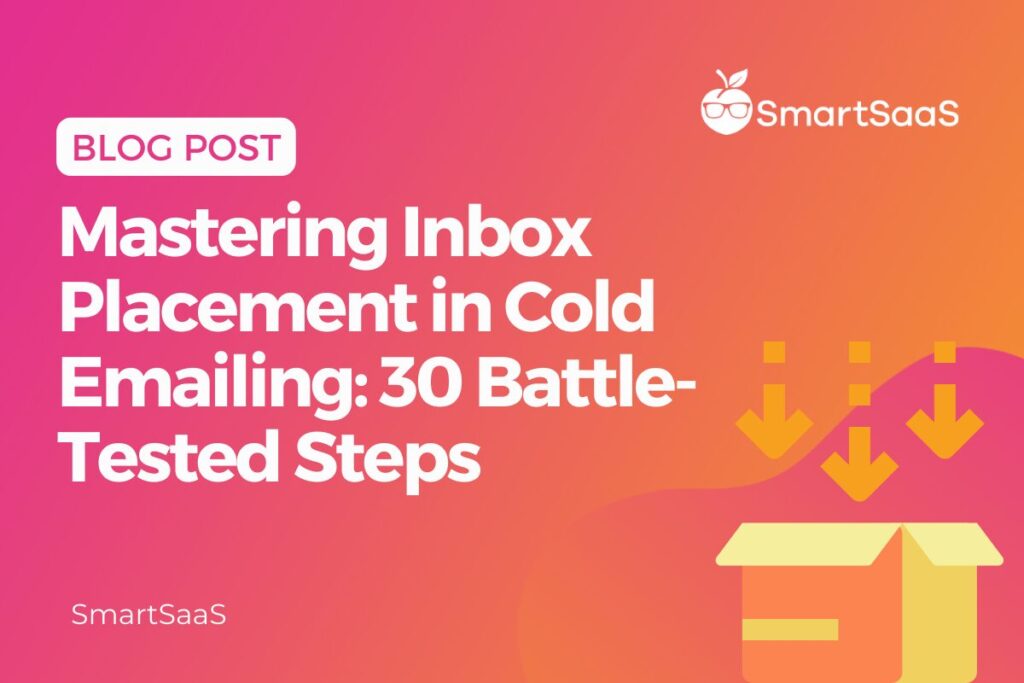Troubleshooting Email Deliverability: Issues & Resolutions

You’ve dedicated effort to create an email marketing campaign, but then you discover that your emails aren’t reaching your intended audience. Despite investing hours in refining your message, developing content, and writing compelling subject lines, you find that your emails aren’t getting through.
Not sure what went wrong? Cold emailing plays a pivotal role in any successful business approach, yet ensuring your emails land in the right inboxes is increasingly challenging. In this post, we’ll dive into common email deliverability issues and share effective solutions to address these challenges.
The Importance of Email Deliverability in Cold Email Campaigns
When it comes to cold email campaigns, email deliverability is the critical factor that determines the success of your email marketing efforts. In simple terms, email deliverability refers to the ability of your emails to reach your target audience’s inbox without being blocked or marked as spam.
Why is Email Deliverability Important?
There are several reasons why email deliverability is crucial for the success of your cold email campaign:
- Higher Open Rates: When your emails reach your target audience’s inbox, there is a greater chance that they will be opened and read. This leads to higher open rates, which is one of the critical metrics for measuring the success of your email marketing efforts.
- Increased Engagement: Emails that are delivered to the inbox are more likely to be engaged with, whether that means clicking on a link, replying to the email, or taking some other action. This leads to increased engagement and higher conversion rates.
- Better Reputation: When your emails are delivered to the inbox, it helps to establish your reputation as a trustworthy sender. This can lead to better email deliverability in the future, as ISPs are more likely to trust your emails and deliver them to the inbox.
Factors That Impact Email Deliverability
Several factors can impact the deliverability of your emails, including:
- IP address reputation
- Bounce rate
- Unsubscribe rate
- Complaint rate
- Spam trap hits
- Domain reputation
- Sending frequency
Common Email Deliverability Problems
Despite your best efforts, your open rates could be better, and your emails vanish into the depths of the spam folder. Here comes the big question: What could be going wrong? Here are some common mistakes that might be sabotaging your email deliverability and open rates:
1. Your Email Accounts Aren’t Set Up Properly (Yikes!)
Not having SPF, DKIM, and DMARC adequately set up is like leaving your house without locking the door; you’re just inviting trouble. These essential security features help protect your email accounts from being flagged as spam. So, don’t ignore them!
2. Your Subject Lines Are Boring
Generic, salesy subject lines will make your audience sleep faster than counting sheep. Instead, make your subject lines exciting and targeted to grab their attention.
3. Your Email Account Is as Cold as Ice
Have you warmed up your emails before sending cold emails? If not, you might see lower open rates. Your domain’s reputation, age, and the reputation of your sending accounts all affect your deliverability. So, make sure to warm up before diving into the deep end!
4. You’re an Email Overachiever
Sending too many emails can raise red flags and land your emails in the spam folder. Stick to a maximum of 50 daily emails per account to avoid being flagged.
5. Your Emails Are a Spam Word Minefield
Using spam words is like stepping on a landmine, blowing your deliverability rates to smithereens.
6. Your Emails Are as Personal as a Robocall
If your emails look like a robot churned them out, your audience will hit the delete button faster than you can say, “unsubscribe.” Make sure to personalize your emails to pique their interest.
7. Your Lead List Is Shadier Than a Used Car Salesman
Unverified lead lists are a recipe for disaster. They result in bounces, which damage your sending reputation.
8. Your Emails Are Flashier Than a Vegas Casino
Using images and links in your emails is a good idea, but they can land you in the spam folder. Keep it simple and avoid these flashy tactics to maintain deliverability.
9. Your Tracking Domain Is as Generic as a White T-Shirt
A custom tracking domain lets you stand out and improve your deliverability. So, don’t be generic; make it personal!
10. You’re on the Email Blacklist
Being on a blacklist is like being an outcast at a party; no one wants to be associated with you. If your domain is on multiple blacklists, consider replacing it with a new sending domain and accounts.
11. You’re Targeting Generic Email Addresses
Sending emails to generic addresses like info@company is less likely to get a response than targeting personal addresses like name@company. Make it personal!
12. You’re Sending Emails at the Worst Times
Timing is everything. Sending emails after work hours, on weekends, or during holidays will lower open rates. Timing, my friend, is vital!
13. Your Email Service Provider’s IP Has a Bad Rep
Even if you’re using a significant provider, your email service provider’s IP could be blacklisted, affecting your deliverability. Stay vigilant and check their IP reputation.
14. Your Tracking Pixel Is Disabled
Some email clients disable tracking pixels by default, making it impossible to track open rates. Unfortunately, this is an industry-wide problem, so be aware of this limitation.
15. Your Email Domain Leads to Nowhere
Having your email domain point to a website can improve your email deliverability. To fix this, redirect your domain to your main website or use a name record with SSL.
The solution to poor deliverability
To overcome email deliverability issues, businesses must focus on three key areas: their email list, sender reputation, and email content.
Email List Best Practices
The first area to focus on is your email list. Your email list should be clean and up-to-date. It’s essential to remove inactive subscribers or those who have unsubscribed regularly. This will not only improve your deliverability rates, but it will also increase your engagement rates, as you’ll be targeting a more relevant audience. Additionally, you should segment your email list to send targeted messages to different groups. For example, you can segment your list by location, interests, or purchase history.
Sender Reputation Best Practices
The second area to focus on is your sender reputation. Your sender reputation is a score that determines how trustworthy your emails are. Internet service providers (ISPs) use this score to decide whether to deliver your emails to the inbox or the spam folder. To maintain a good sender reputation, you should follow email best practices, such as avoiding spam trigger words, using a recognizable sender name, and sending emails only to people who have opted-in. Additionally, you should monitor your sender reputation using tools like Sender Score or GlockApps.
Cold Email Content Best Practices
The third area to focus on is your email content. Your email content should be engaging, relevant, and valuable to your subscribers. It should also be optimized for mobile devices and include a clear call to action. Your subject line is also crucial, as it’s the first thing your subscribers see. It should be concise, attention-grabbing, and avoid spam trigger words. Finally, you should test your emails before sending them to ensure they look good on different email clients and devices.
Focusing on these three key areas can improve your email deliverability rates and increase your engagement rates. Remember, your subscribers are your most valuable asset, so treat them with respect and provide them with value.
Related Content in Our Marketplace
-
Mastering Startup Revenue Growth: Sales and Marketing Bootcamp
-
Email Deliverability Cheat Sheet
-
High Email Deliverability Checklist
-
Spam Filter & Deliverability Checklist
-
Email Quality Assurance Guide with Checklist
-
Email deliverability Guide: Setting-Up SPF, DKIM & DMARC
-
Emergency Campaign Checklist






Responses